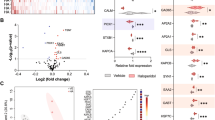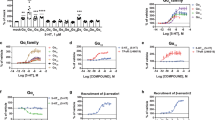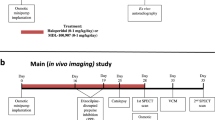Abstract
This study was designed to compare some behavioral and biochemical effects of chronic treatment with a range of antipsychotic drugs. Gene expression of enkephalin, chromogranin A, chromogranin B, and secretogranin II and their respective peptide products were studied with in situ hybridization and radioimmunoassays after daily oral administration of haloperidol, clozapine, risperidone, or zotepine for 21 days. In behavioral tests, significant catalepsy was induced by haloperidol only. All four antipsychotic drugs increased hind paw retraction time but only haloperidol also increased forelimb retraction time. In the caudate putamen, haloperidol increased both enkephalin mRNA expression and enkephalin tissue levels. Neither of these parameters was altered by the other three drugs. In the prefrontal cortex, antipsychotic drugs generated a distinct pattern of gene expression in two regards. First, the dopamine D2 receptor antagonist, haloperidol, did not significantly alter synaptic protein levels or their encoding mRNAs. Secondly, there was a differential change in tissue levels and mRNA expression since secretogranin II was not affected by any tested antipsychotic drug. This study shows that different types of antipsychotic drug induce distinct behavioural effects as well as differential changes in the biosynthesis of synaptic proteins and their encoding mRNAs. The data reinforce the notion that haloperidol can be classed as a typical antipsychotic drug whilst clozapine, zotepine, and risperidone reflect their atypical classification.
Similar content being viewed by others
Log in or create a free account to read this content
Gain free access to this article, as well as selected content from this journal and more on nature.com
or
References
Angulo JA . (1992): Involvement of dopamine D1 and D2 receptors in the regulation of proenkephalin mRNA abundance in the striatum and accumbens of the rat brain. J Neurochem 58: 110–1109
Arnt J, Skarsfeldt T . (1998): Do novel antipsychotics have similar pharmacological characteristics? A review of the evidence. Neuropsychopharmacology 18: 63–101
Atkins JB, Chlan-Fourney J, Nye HE, Hiroi N, Carlezon WA, Nestler EJ . (1999): Region-specific induction of deltaFosB by repeated administration of typical versus atypical antipsychotic drugs. Synapse 33: 118–128
Augood SJ, Westmore K, Faull RL, Emson PC . (1993): Neuroleptics and striatal neuropeptide gene expression. Prog Brain Res 99: 181–199
Chanat E, Weiss U, Huttner WB, Tooze SA . (1993): Reduction of the disulfide bond of chromogranin B (secretogranin I) in the trans-Golgi network causes its missorting to the constitutive secretory pathways. EMBO J 12: 2159–2168
Comb M, Seeburg PH, Adelman J, Eiden L, Herbert E . (1982): Primary structure of the human met- and leu-enkephaline precursor of its mRNA. Nature 295: 663–666
Deutch AY, Duman RS . (1996): The effects of antipsychotic drugs on Fos protein expression in the prefrontal cortex: Cellular localization and pharmacological characterization. Neuroscience 70: 377–389
Ellenbroek B, Cools AR . (1988): The Paw Test: An animal model for neuroleptic drugs which fulfils the criteria for pharmacological isomorphism. Life Sci 42: 1205–1213
Ellenbroek BA, Prinssen EP, Cools AR . (1994): The role of serotonin receptor subtypes in the behavioural effects of neuroleptic drugs. A paw test study in rats. Eur J Neurosci 6: 1–8
Ezrin WC, Seeman P . (1977): Tolerance of haloperidol catalepsy. Eur J Pharmacol 41: 321–327
Fleischhacker WW, Hummer M . (1997): Drug treatment of schizophrenia in the 1990s. Achievements and future possibilities in optimising outcomes. Drugs 53: 915–929
Forss PS, Danielson P, Battenberg E, Bloom F, Sutcliffe JG . (1989): Nucleotide sequence and cellular distribution of rat chromogranin B (secretogranin I) mRNA in the neuroendocrine system. J Mol Neurosci 1: 63–75
Gerdes HH, Phillips E, Huttner WB . (1988): The primary structure of rat secretogranin II deduced from a cDNA sequence. Nucl Ac Res 16: 11811
Guo N, Vincent SR, Fibiger HC . (1998): Phenotypic characterization of neuroleptic-sensitive neurons in the forebrain: Contrasting targets of haloperidol and clozapine. Neuropsychopharmacology 19: 133–145
Herman ZS, Huzarska M, Kmieciak KK, Kowalski J . (1991): Chronic treatment with chlorpromazine, thioridazine or haloperidol increases striatal enkephalins and their release from rat brain. Psychopharmacology (Berl) 104: 106–112
Hiroi N, Graybiel AM . (1996): Atypical and typical neuroleptic treatments induce distinct programs of transcription factor expression in the stratium. J Comp Neurol 374: 70–83
Huttner WB, Gerdes HH, Rosa P . (1991): The granin (chromogranin/secretogranin) family. TIBS 16: 27–30
Hyman SE, Nestler EJ . (1996): Initiation and adaptation: A paradigm for understanding psychotropic drug action. Am J Psychiatry 153: 151–162
Iacangelo A, Okayama H, Eiden LE . (1988): Primary structure of rat chromogranin A and distribution of its mRNA. FEBS Lett 227: 115–121
Ichikawa J, Kuroki T, Dai J, Meltzer HY . (1998): Effect of antipsychotic drugs on extracellular serotonin levels in rat medial prefrontal cortex and nucleus accumbens. Eur J Pharmacol 351: 163–171
Kirchmair R, Hogue-Angeletti R, Gutierrez J, Fischer-Colbrie R, Winkler H . (1993): Secretoneurin—a neuropeptide generated in brain, adrenal medulla and other endocrine tissues by proteolytic processing of secretogranin II (chromogranin C). Neuroscience 53: 359–365
Knable MB, Weinberger DR . (1997): Dopamine, the prefrontal cortex and schizophrenia. J Psychopharmacol 11: 123–131
Kroesen S, Marksteiner J, Leitner B, Hogue Angeletti R, Fischer Colbrie R, Winkler H . (1996): Rat brain: distribution of immunoreactivity of PE-11, a peptide derived from chromogranin B. Eur J Neurosci 8: 2679–2689
Kroesen S, Marksteiner J, Mahata SK, Mahata M, Fischer Colbrie R, Saria A, Kapeller I, Winkler H . (1995): Effects of haloperidol, clozapine and citalopram on messenger RNA levels of chromogranins A and B and secretogranin II in various regions of rat brain. Neuroscience 69: 881–891
Le Moine C, Normand E, Bloch B . (1991): Phenotypical characterization of the rat striatal neurons expressing the D1 dopamine receptor gene. Proc Natl Acad Sci USA 88: 4205–4209
Leysen JE, Janssen PM, Schotte A, Luyten WH, Megens AA . (1993): Interaction of antipsychotic drugs with neurotransmitter receptor sites in vitro and in vivo in relation to pharmacological and clinical effects: Role of 5HT2 receptors. Psychopharmacology (Berl) 112: S40–S54
Lieberman JA, Sheitman BB, Kinon BJ . (1997): Neurochemical sensitization in the pathophysiology of schizophrenia: Deficits and dysfunction in neuronal regulation and plasticity. Neuropsychopharmacology 17: 205–229
MacArthur L, Eiden L . (1996): Neuropeptide genes: targets of activity-dependent signal transduction. Peptides 17: 721–728
Mahata SK, Mahata M, Marksteiner J, Sperk G, Fischer-Colbrie R, Winkler H . (1991): Distribution of mRNAs for chromogranin A and B and secretogranin II in rat brain. Eur J Neurosci 3: 895–904
Mahata SK, Mahata M, Parmer RJ, O'Connor DT . (1999): Desensitization of catecholamine release. The novel catecholamine release-inhibitory peptide catestatin (chromogranin a344-364) acts at the receptor to prevent nicotinic cholinergic tolerance. J Biol Chem 274: 2920–2928
Marin C, Engber TM, Bonastre M, Chase TN, Tolosa E . (1996): Effect of long-term haloperidol treatment on striatal neuropeptides: Relation to stereotyped behavior. Brain Res 731: 57–62
Marksteiner J, Kirchmair R, Mahata SK, Mahata M, Fischer-Colbrie R, Hogue-Angeletti R, Saria A, Winkler H . (1993a): Distribution of secretoneurin, a peptide derived from secretogranin II, in rat brain: An immunocytochemical and radioimmunological study. Neuroscience 54: 923–944
Marksteiner J, Saria A, Miller CH, Krause JE . (1993b): Increased synthesis of neurokinin B and enkephalin after chronic haloperidol treatment. Regul Pept 46: 349–351
Marksteiner J, Sperk G . (1988): Concomitant increase of somatostatin, neuropeptide Y and glutamate decarboxylase in the frontal cortex of rats with decreased seizure threshold. Neuroscience 26: 379–385
Mercugliano M, Chesselet MF . (1992): Clozapine decreases enkephalin mRNA in rat striatum. Neurosci Lett 136: 10–14
Mijnster MJ, Ingham CA, Meredith GE, Docter GJ, Arbuthnott GW . (1996): Morphological changes in met(5)-enkephalin-immunoreactive synaptic boutons in the rat neostriatum after haloperidol decanoate treatment. Eur J Neurosci 8: 716–726
Mijnster MJ, Schotte A, Docter GJ, Voorn P . (1998): Effects of risperidone and haloperidol on tachykinin and opioid precursor peptide mRNA levels in the caudate-putamen and nucleus accumbens of the rat. Synapse 28: 302–312
Needham PL, Atkinson J, Skill MJ, Heal DJ . (1996): Zotepine: Preclinical tests predict antipsychotic efficacy and an atypical profile. Psychopharmacol Bull 32: 123–128
Nguyen TV, Kosofsky BE, Birnbaum R, Cohen BM, Hyman SE . (1992): Differential expression of c-Fos and Zif268 in rat striatum after haloperidol, clozapine, and amphetamine. Proc Natl Acad Sci USA 89: 4270–4274
Normand E, Popovici T, Fellmann D, Bloch B . (1987): Anatomical study of enkephalin gene expression in the rat forebrain following haloperidol treatment. Neurosci Lett 83: 232–236
O'Donnell P, Grace AA . (1998): Dysfunctions in multiple interrelated systems as the neurobiological bases of schizophrenic symptom clusters. Schizophr Bull 24: 267–283
Paxinos G, Watson C . (1986): The rat brain in stereotaxic coordinates, 2nd ed. Sydney, Academic Press
Robertson GS, Fibiger HC . (1992): Neuroleptics increase c-fos expression in the forebrain: Contrasting effects of haloperidol and clozapine. Neuroscience 46: 315–328
Robertson GS, Fibiger HC . (1996): Effects of olanzapine on regional C-Fos expression in rat forebrain. Neuropsychopharmacology 14: 105–110
Robertson GS, Matsumura H, Fibiger HC . (1994): Induction patterns of Fos-like immunoreactivity in the forebrain as predictors of atypical antipsychotic activity. J Pharmacol Exp Ther 271: 1058–1066
Romano GJ, Shivers BD, Harlan RE, Howells RD, Pfaff DW . (1987): Haloperidol increases proenkephalin mRNA levels in the caudate-putamen of the rat: A quantitative study at the cellular level using in situ hybridization. Brain Res 388: 33–41
Schotte A, Janssen PF, Gommeren W, Luyten WH, Van GP, Lesage AS, De LK, Leysen JE . (1996): Risperidone compared with new and reference antipsychotic drugs: In vitro and in vivo receptor binding. Psychopharmacology (Berl) 124: 57–73
Selemon LD, Goldman-Rakic PS . (1999): The reduced neuropil hypothesis: A circuit based model of schizophrenia. Biol Psychiatry 45: 17–25
Shen PJ, Gundlach AL . (1996): Chromogranin mRNA levels in the brain as a marker for acute and chronic changes in neuronal activity: Effect of treatments including seizures, osmotic stimulation and axotomy in the rat. Eur J Neurosci 8: 988–1000
Thiele C, Huttner WB . (1998): The disulfide-bonded loop of chromogranins, which is essential for sorting to secretory granules, mediates homodimerization. J Biol Chem 273: 1223–1231
Acknowledgements
This work was supported by BASF Pharma/Knoll Pharmaceuticals Austrian Science Foundation (SFB F00206) and the Austrian National Bank (P 7150). The excellent technical assistance of I. Berger is gratefully acknowledged.
Author information
Authors and Affiliations
Corresponding author
Rights and permissions
About this article
Cite this article
Bauer, R., Mayr, A., Lederer, W. et al. Further Evidence that Behavioral Tests and Neuropeptide mRNA and Tissue Level Alterations Can Differentiate between Typical and Atypical Antipsychotic Drugs. Neuropsychopharmacol 23, 46–55 (2000). https://doi.org/10.1016/S0893-133X(00)00086-5
Received:
Revised:
Accepted:
Issue date:
DOI: https://doi.org/10.1016/S0893-133X(00)00086-5
Keywords
This article is cited by
-
Treatments for schizophrenia: a critical review of pharmacology and mechanisms of action of antipsychotic drugs
Molecular Psychiatry (2005)



